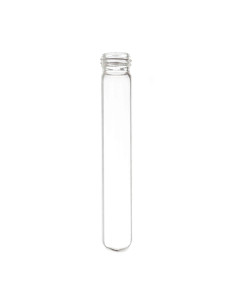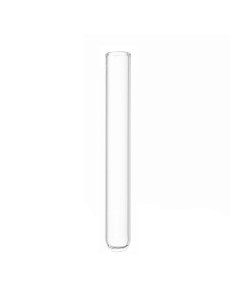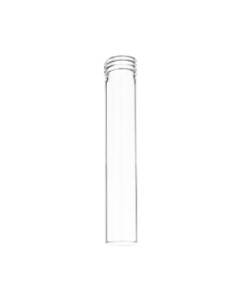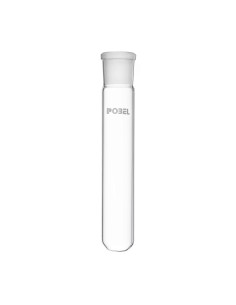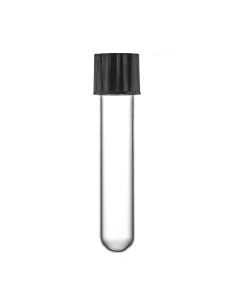Laboratory test tubes are essential in any scientific environment, whether in chemistry, biology, medicine or research laboratories. Designed to hold small amounts of liquids or solids, these tubes are crucial for accurate experiments and analysis. Their simple yet effective design allows scientists and technicians to handle chemicals safely and efficiently, facilitating the observation of reactions and the performance of multiple tests under controlled conditions. In addition, their versatility makes them indispensable in a wide range of scientific and educational applications, making them crucial laboratory equipment everywhere.
What are test tubes like?
Test tubes are cylindrical containers usually made of borosilicate glass or plastic (polypropylene). They have an elongated body and a rounded or flat base, with a narrow top opening to facilitate pouring and mixing of liquids. The transparency of the material allows users to easily observe chemical reactions and other processes occurring inside.
Materials used in Pobel test tubes:
Borosilicate glass: this material is highly resistant to thermal and chemical shocks, making it ideal for applications involving sudden temperature changes. Borosilicate glass is transparent, allowing clear visualisation of reactions. It is commonly used in test tubes because of its durability and corrosion resistance. In addition, its smooth, non-porous surface minimises the possibility of contamination, ensuring accurate and reliable results.
Polypropylene (PP): This plastic is known for its chemical and impact resistance, making it suitable for situations requiring greater physical strength. Polypropylene test tubes are lightweight and autoclavable, allowing them to be sterilised at high temperatures without compromising their structural integrity. This feature makes them ideal for applications where hygiene and sterility are crucial, such as in microbiology and biotechnology laboratories.
What are test tubes used for?
Test tubes have a variety of applications in different scientific and industrial sectors:
Common applications:
Chemical analysis: used for mixing and reacting small amounts of reagents. Test tubes allow chemists to observe reactions and measure changes accurately.
Culture of microorganisms: ideal for the growth and observation of bacteria and fungi. These tubes provide a controlled environment for the study of microorganisms in microbiology.
Heat tests: suitable for heating substances to different temperatures. Their heat resistance makes them perfect for thermal studies and stability analysis.
Temporary storage: used to contain liquid or solid samples for short periods. Their compact and airtight design ensures that samples remain intact and uncontaminated.
Decanting: used to separate immiscible liquids. Test tubes facilitate phase separation in analytical and preparative chemistry studies.
Reaction observation: used to visualise colour changes and precipitates in chemical reactions. The transparency of the test tubes allows clear and detailed observation of chemical processes.
Areas of use:
Chemical laboratories: essential for measuring, mixing and heating chemical reagents. They are an essential tool for research and development in industrial and academic chemistry.
Biological research: used to prepare and store solutions and culture media. Biologists use them for a variety of applications, from cell culture to the preparation of test solutions.
Pharmaceutical industry: crucial for drug development and testing. Test tubes are vital in the research and development phase of new drugs and in the quality control of pharmaceutical products.
Education: essential tools in educational experiments to teach basic principles of science. In classrooms and educational laboratories, students learn to perform basic experiments and understand fundamental scientific principles.
Food industry: used for quality testing and analysis of food products. They help food scientists ensure that products meet quality and safety standards.
How are test tubes used?
The correct use of test tubes is essential for accurate measurements and results. The basic procedure is detailed below:
Selection of the right tube: choose a test tube with the right capacity for the volume to be measured or reacted. It is important to select the correct size to avoid spillage and to ensure accurate measurements.
Cleanliness: ensure that the test tube is clean and dry before use to avoid contamination. A clean tube ensures that there is no interference with reactions or measurements.
Filling: pour the liquid or solid into the test tube to the desired level. Be sure to measure the volume accurately to obtain accurate results.
Heating (if necessary): use a Bunsen burner or hot plate, making sure that the tube is properly clamped to avoid burns. It is crucial to follow safety protocols when working with heat.
Observation: observe the reactions or processes occurring in the test tube, recording any noticeable changes. Documenting the results is essential for later analysis.
After-cleaning: clean the test tube after use to maintain its condition and avoid cross-contamination. Proper maintenance prolongs the life of the test tubes.
Is certification required to use this type of material?
Yes, in many cases certification is necessary to ensure that the test tubes meet the required standards of accuracy and safety. Certifications ensure that the test tubes have been manufactured and calibrated according to strict quality control procedures. Some relevant international standards include:
USP: The United States Pharmacopeia sets standards for the purity, quality and consistency of pharmaceutical products and laboratory materials. These standards ensure that test tubes meet the necessary requirements for use in critical applications.
Frequently asked questions
What is the test tube called?
The test tube is commonly known as a ‘tubo de ensayo’ in Spanish, and in English it is called a ‘test tube’.
What holds the test tube?
The test tube is usually held with a test tube clamp or a specific support designed to keep the tubes in an upright position. These holders are essential to prevent spillage and allow safe handling of hot or reactive substances. The stability provided by the supports ensures that experiments are conducted safely and efficiently.




